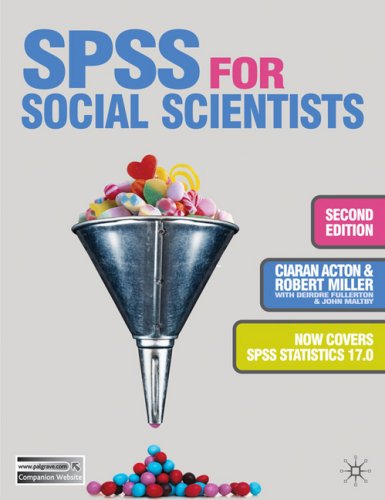SPSS for Social Scientists
Miller, Robert, Acton, Ciaran, Fullerton, Deirdre and Maltby, John
Palgrave Macmillan Ltd, Basingstoke
2009
0-230-20993-9 (pb)
 I have used SPSS to analyse social research data for about ten years now. I first learned how to use the software through coaching by experienced users. This was a challenging experience as the coaching did not always go at my pace. Similar challenges confront current SPSS beginners. In a shared office space for postgraduate Sociology students at the University Aberdeen, a remark by a frustrated student screams on the notice board, 'SPSS I hate you!' Proper use of this book can endear SPSS to such students.
I have used SPSS to analyse social research data for about ten years now. I first learned how to use the software through coaching by experienced users. This was a challenging experience as the coaching did not always go at my pace. Similar challenges confront current SPSS beginners. In a shared office space for postgraduate Sociology students at the University Aberdeen, a remark by a frustrated student screams on the notice board, 'SPSS I hate you!' Proper use of this book can endear SPSS to such students.
From its title, one might mistake this book for a user manual, but it is far more than that! The authors provide a succinct introduction to the paradigmatic contentions surrounding the application of quantitative measurement and analysis to social phenomena. This first chapter emphasises that good research design is necessary for useful quantitative social analysis, even though this is not the focus of the book. The authors have reiterated in their concluding chapter that users should acquaint themselves with social research design and provided some helpful references.
The authors adopt a practical and non-technical approach, devoid of statistical notations. The utility of this second edition of the book is enhanced by use of the latest version of SPSS software (SPSS statistics 17.0) and data from the International Social Survey Programme (ISSP) - which are available for free download - to illustrate key contents.
While seemingly simple to an experienced user, some of the tips in the book will be most helpful to novice researchers. Tips on how to make adjustments to SPSS by resetting variable lists and output labels (pages 18 and 19) are particularly useful. Because SPSS is Excel-based, one of the challenges new users face is locating specific variables for analysis and defining analysis outputs. Alphabetical listing of variables and including variable names and labels in outputs can alleviate these challenges. Other important procedural information in the book includes appropriate definition of variables, specification of measurement levels and how to treat missing data in analysis. Closely linked to these are the tips on data manipulation and selection that encourage analysis of a sub-set of variables most relevant to specific questions rather than using an entire database, for efficiency.
Data entry in SPSS is prone to errors especially because of lack of checks for valid values and for inconsistencies. While the authors recognise this weakness, and mention that there are programmes that may enhance accuracy during data entry, they fail to mention any specific programmes (page 47). While it is understandable that the authors might have avoided identifying these programmes by name because they are not linked to SPSS, it would have been helpful to explain that some of the software are available online free of charge and to even provide links to their websites for interested users to pursue further e.g. EpiData software.
Chapters 4 through 11 provide an excellent step-by-step approach to performing exploratory and inferential statistical analyses in SPSS. The strength of these chapters lay in the clear interpretation of outputs, explanation of their statistical foundations and identification of requirements for application of specific tests. SPSS provides diagnostic information on the stability of tests performed given the data available, which the authors have clearly explained. A good example is the explanation of cell frequency requirements for the chi-square test (page 150).
My one caveat would be that the authors have not linked adequately exploratory and inferential statistical approaches in their presentation. The chapters on multivariate analysis make limited reference to exploratory analysis discussed in earlier chapters. The importance of exploratory analysis to the identification of covariates to include in multivariate analysis and a gradual analysis process starting from simple to advanced approaches could be emphasised.
This book is an ideal resource for new users of SPSS as well as those seeking a deeper understanding of some of the software's capabilities. The book is suitable both as an introductory and an intermediate course book.
Willis O. Odek
University of Aberdeen

